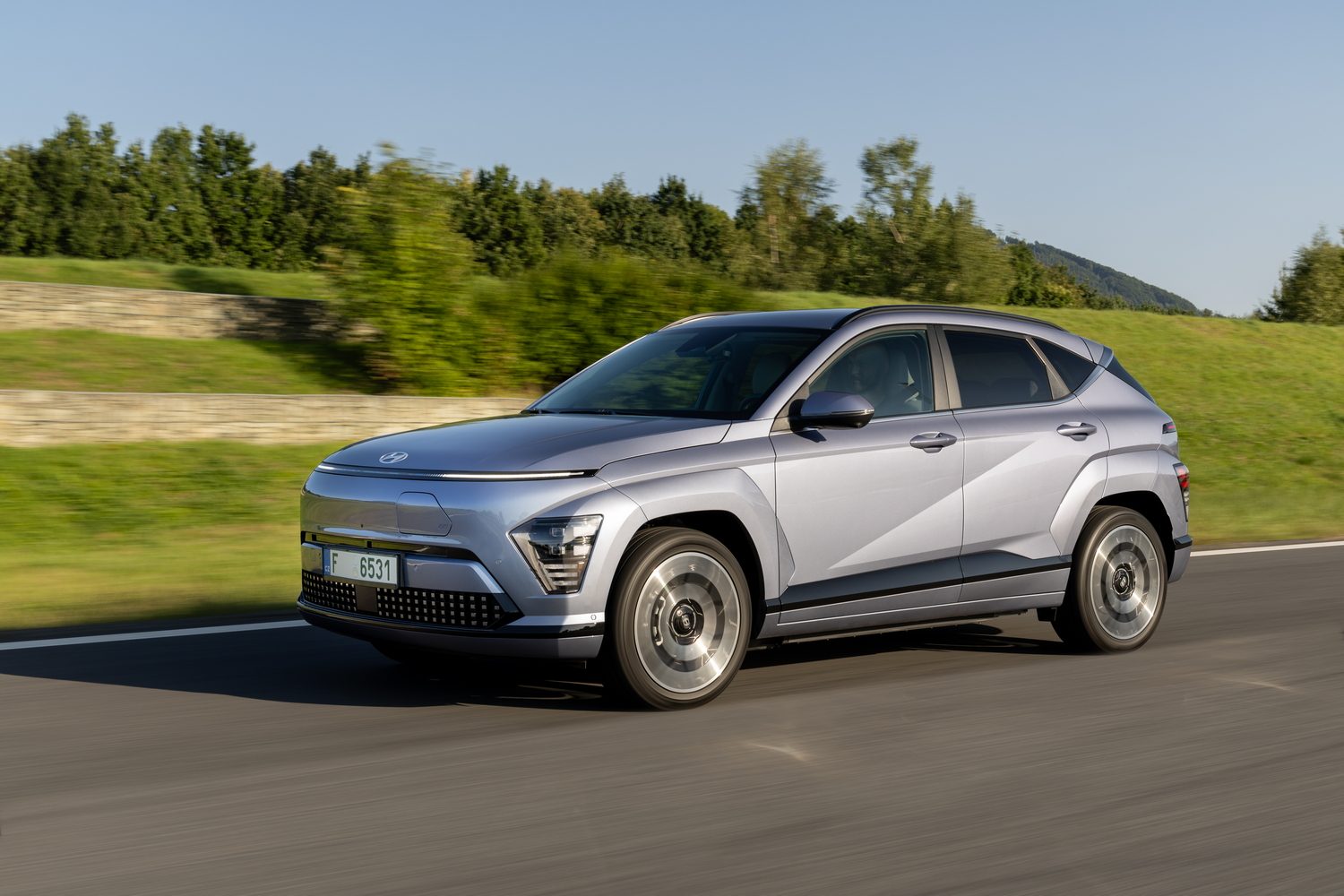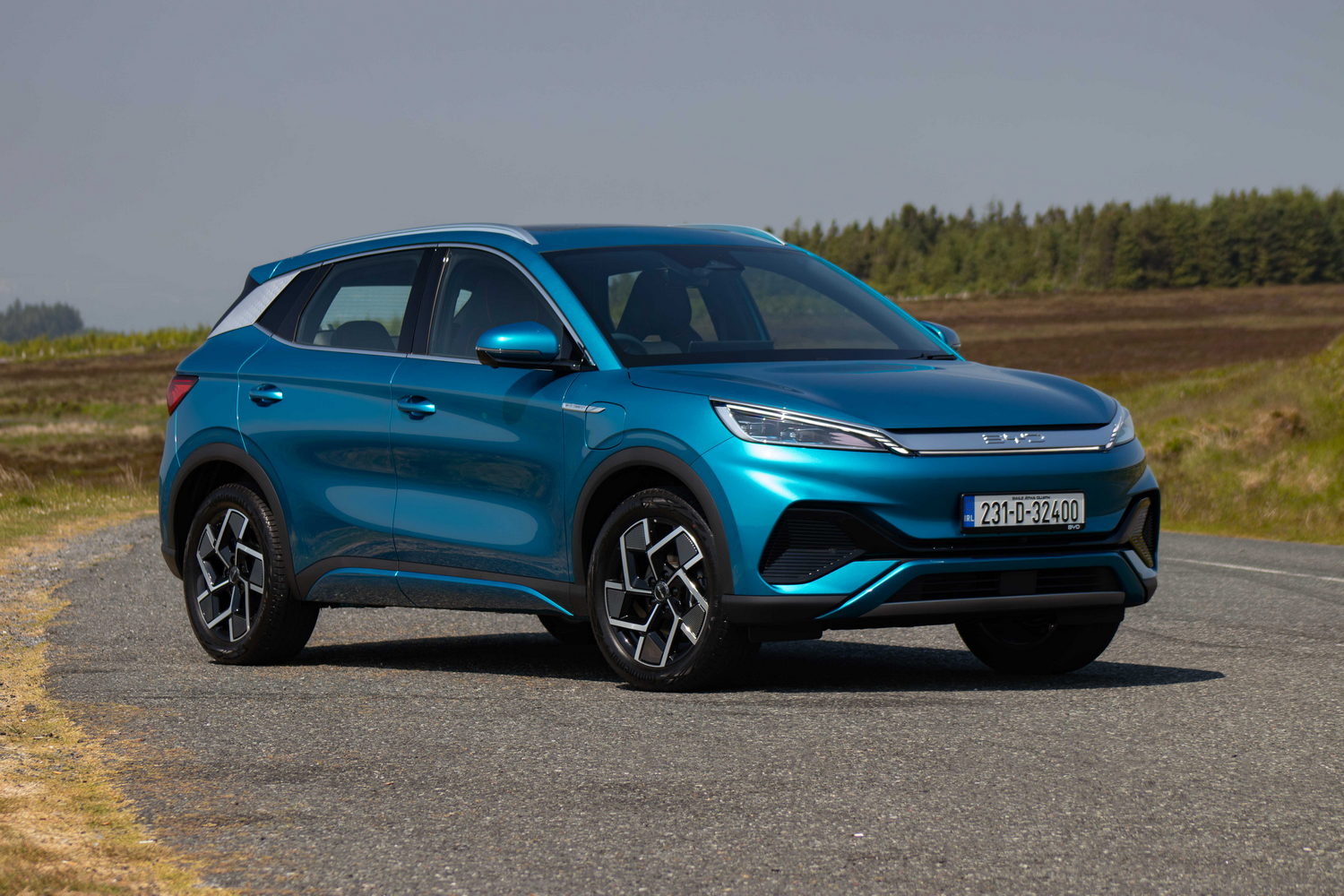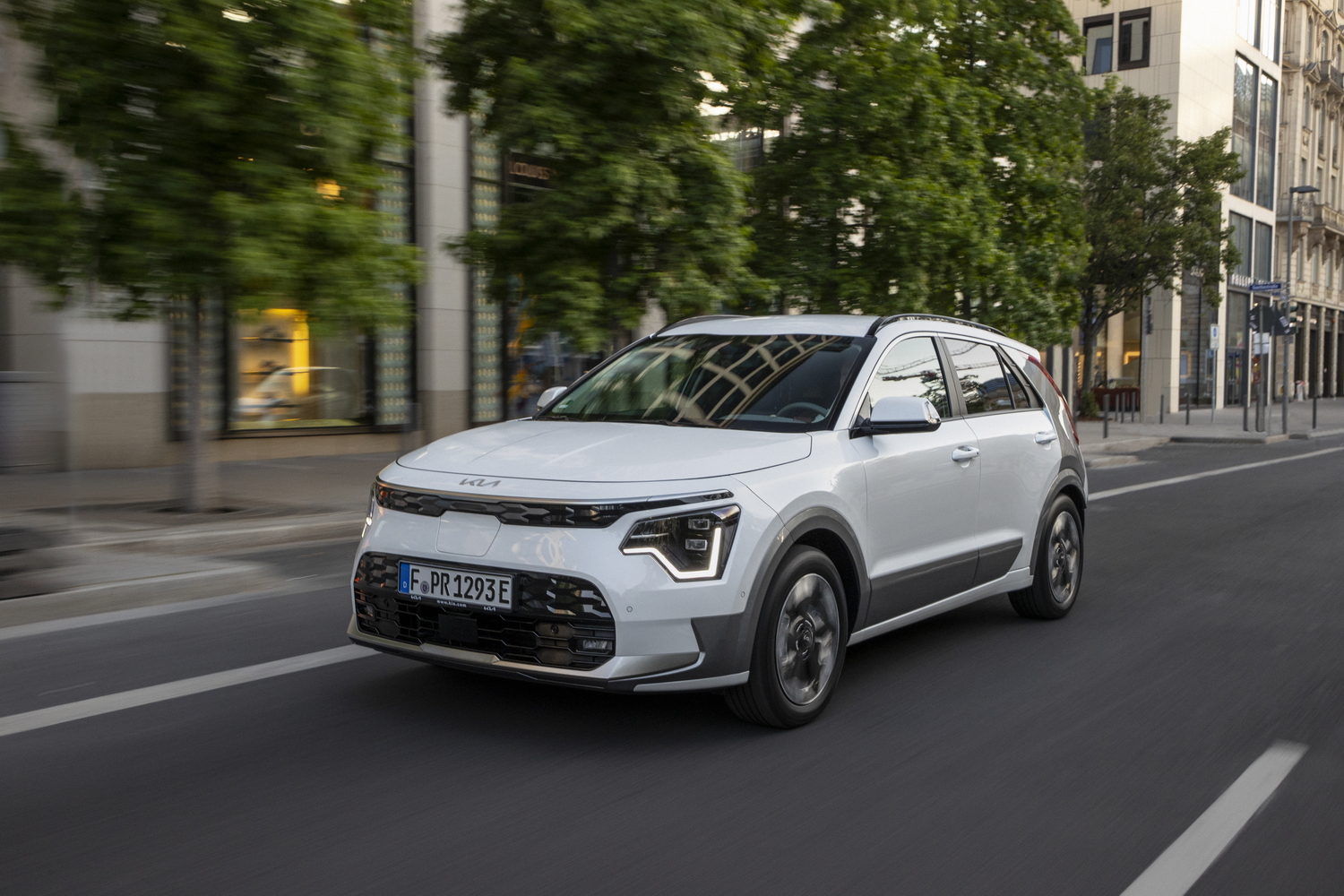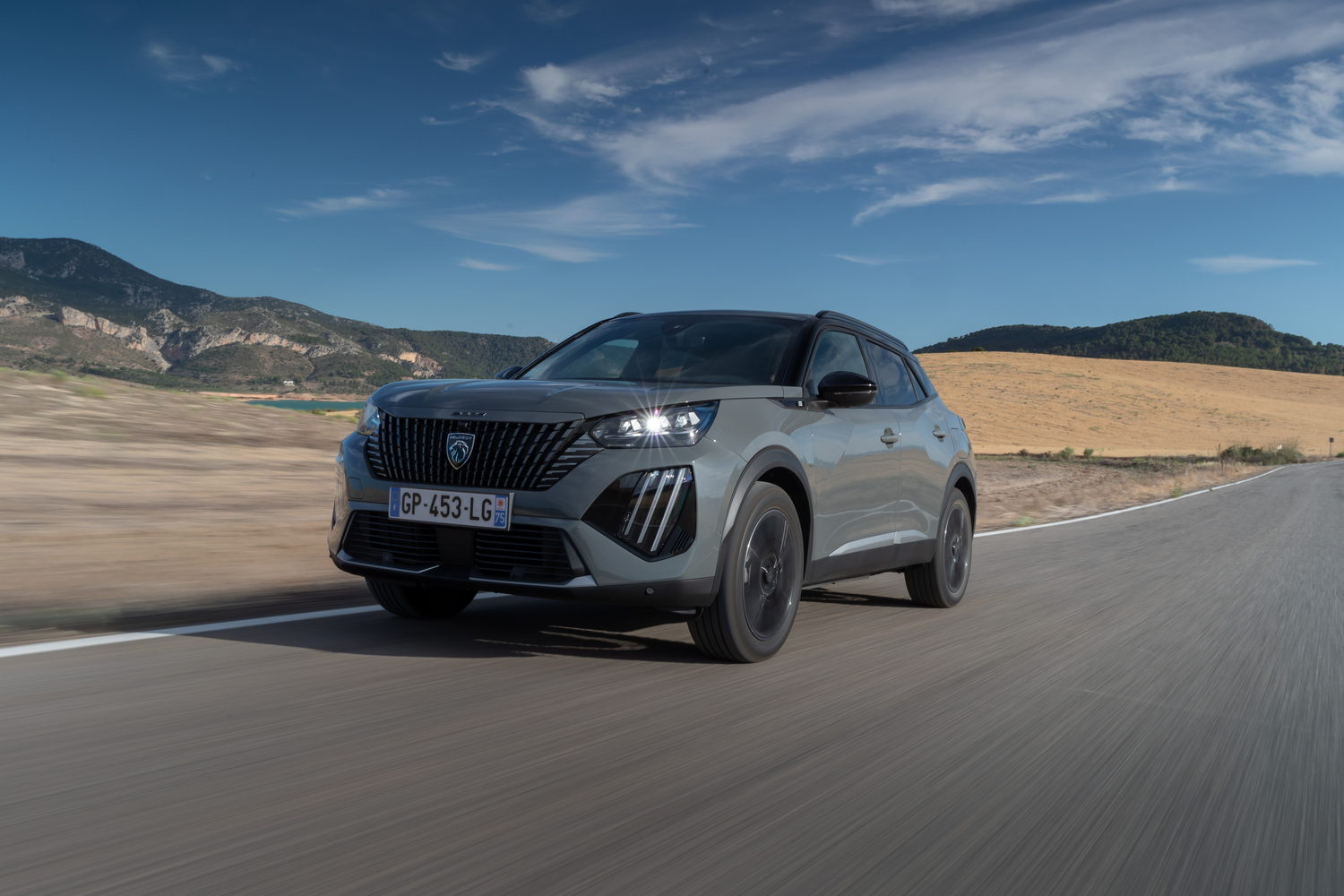The first-generation Hyundai Kona Electric was a talented zero-emissions vehicle which brought electric motoring to the relatively affordable compact family car segment. This time around, the sharp-suited new Kona Mk2 gets the same treatment, with improved driving range and performance. We've driven it to see how it stacks up against an increasingly talented array of electric rivals.
In the metal
Hyundai's styling has been getting ever more daring in recent years, with the new Kona taking clear visual inspiration from the smaller Bayon crossover, the larger Tucson SUV and of course the company's chunky electric hatchback, the Ioniq 5. The defining feature of the new Kona is the 'seamless horizon lamps', which are a pair of super-thin light bars stretching the width of the body both front and rear. They give what is already a futuristic-looking car - complete with wild creases and various eye-catching details on its sides - a truly robotic vibe, which some people will love, and others may not be so keen on. We're definitely in the former camp: there isn't a crossover in the Kona's class that's anything like as interesting to look at as this thing is.
Stepping inside, one of the benefits of the new model is increased space, brought about because the body is now much bigger. So now taller adults can sit in the back of the Kona in comfort, while the boot has swelled to a relatively massive 466 litres with all the seating in use - and there's a 'frunk' under the bonnet with room for charging cables. There are also useful storage cubbies throughout the cabin, which makes this a fine choice as a compact vehicle needed primarily for family duties.
What's really good about the Kona's cabin, though, is the quality look and feel of it, and the technology on offer. Sure, there are plastics lower down in the cabin which betray their built-to-a-cost purpose, while the tops of the door cards feel quite plain, but the major touchpoints inside the Kona are all uniformly excellent. There's also plenty of traditional switchgear, including a separate climate control panel, which means using the car's onboard functions is simple and intuitive, while the overall design is pleasant to gaze upon. There's a full widescreen display of both the 12.3-inch touchscreen infotainment and the 12.3-inch digital instrument cluster, standard-fit in every Kona Electric. Buyers of the top-grade Platinum cars will also gain a head-up display in the windscreen.
Generally, despite a few areas where the Kona's status as something lesser in the hierarchy than the Hyundai Tucson becomes obvious, this is a top-notch cabin with loads of space, the company's usual healthy roster of standard equipment and plenty of visual appeal too. Outside and in, the Kona is already looking like a winner.
Driving it
The old Kona Electric had two battery sizes, the larger of which was rated at 64kWh. It's not a huge increase this time around, as the bigger battery pack is now 65.4kWh (that's the usable capacity, incidentally), and the same goes for an increase in peak power from 150kW (204hp) to 160kW (218hp). But, usefully enough, efficiency gains mean that Hyundai can quote up to 514km of range from the 65.4kWh Kona. That figure would drop to 454km if the car was fitted with 19-inch alloys, which are available in other markets, but over here every Kona Electric comes on the range-boosting 17-inch wheels as standard.
There is a cheaper, more accessible 48.4kWh model, with peak power dropped to 115kW (156hp) and a driving range reduced to 377km accordingly, but in reality, most will want the version with the larger battery. With the rotating D-N-R drive selector from the Hyundai Ioniq 5 mounted on the steering column, plus paddles on the steering wheel that allow the driver to adjust the level of regenerative braking through five stages from completely off to stopping power so strong there's one-pedal driving capability, the Kona Electric is easy to get going - and, once you're on the move, you'll be astonished by the refinement of the whole package.
While the old Kona was certainly not bad in terms of ride comfort and the suppression of noises from the tyres or wind blustering round the passenger compartment, the new one feels several steps up in terms of the sheer quality manner in which it drives around. Soft suspension does a good job of soaking up imperfections in the tarmac, so you don't feel much about the road's surface condition at all, even when you're on poorly finished urban streets. Yet it's the lack of audible issues which really impresses - the suspension makes no clonks or bangs when it's in action, tyre roar is pretty much absent everywhere below 100km/h and the aerodynamic form of the Kona Electric leads to an incredibly peaceful passenger compartment.
In essence, the Kona Electric a delight to pilot around town, where the steering is smooth and precise, and the brake pedal feels fairly natural as electric vehicles go - the judgment of the one-pedal driving mode is also spot on from Hyundai, as you can quickly get used to the way it brings the car to a total halt without using the brake pedal.
However, once you're out on the open road, the comportment of the Kona doesn't go to pot; it still feels a big, very grown-up kind of car on faster arterial routes. It's a highly polished machine in this regard, especially among similar electric rivals in the compact crossover class.
While the body control is good, with only a small amount of lean evident in the corners, and the steering is adjustable through three modes - one of which is Sport, where it becomes heavier but not particularly communicative - and there's grip aplenty from the Hyundai's underpinnings, it's never actually fun to throw about. It will take on corners at a fair speed if you want it to, but there are alternative electric vehicles (EVs) which do this sort of road-holding flair better than the Kona. That, though, is more than paid off thanks to the superb and slick way the Hyundai does more sedate daily driver duties, so merely OK handling is not a deal-breaker at all - and most buyers don't care about such things anyway.
What you get for your money
Hyundai sells the Kona Electric in two basic specifications, known as the Elegance and the Platinum. The 48kWh model is only available in the former of these, while you can specify the 65kWh version in either trim - you're looking at prices of €36,995 for the 48kWh Elegance, rising to €40,995 for the 65kWh in the same grade, and €43,995 for the range-topping Platinum.
As with most Hyundais, the standard equipment list is lengthy. Every Kona Electric Elegance comes with 17-inch wheels, electrically powered, folding and heated door mirrors, privacy glass, an electronic parking brake, heated front seats and a heated steering wheel too, dual-zone climate control, automatic lights and wipers, radar cruise control, front and rear parking sensors with a reversing camera, keyless entry and go, the twin 12.3-inch digital screens in the dash, wireless smartphone charging, Apple CarPlay and Android Auto connectivity, a battery heater and a heat pump too, and also a generous amount of advanced driver assist systems (ADAS), among much more.
All the Platinum specification really adds is power adjustment for the front seats, leather upholstery for the seat facings, LED Wide Projector front headlamps, a full 360-degree Surround View Monitor camera set-up, the head-up display for the driver and both Blind Spot Monitor and Blind Spot Collision Warning for the full suite of ADAS tech. Either way, you're getting a lot of kit for your cash with the Kona.
Summary
While the old Hyundai Kona Electric was a worthy small EV with good range, the Korean company has built on that platform by adding true desirability and first-rate refinement to the second-generation model. It doesn't go much further on its electric power, nor does it go there much faster than before either but the new Kona Electric is markedly more pleasurable to waft around in, with occupants revelling in the smooth ride comfort and near-silent interior. That the car looks brilliant (to these eyes) on the outside, has one of the best cabins in the class and also benefits from increased practicality with more room for rear-seat passengers and a much larger boot, only strengthens the Hyundai's case. This is one of the best EVs in the sector as a result.

































